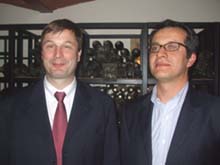The
young 1947, '48, '49,'53, '59
Barring '47 and '48, the others tasted too young, as
if they needed to interact with the barrels for a few more decades before
reaching their prime.
1947 was a special treat for me as it was the year of
India's independence. I wanted to stand up, not only as a mark of respect
to that point in history but also because it was a very good wine. Slightly
astringent, it was lighter bodied with a floral bouquet, lagging marginally
behind the1948, another excellent vintage which I felt was slightly lower
in acidity and higher in sugar, with a slightly shorter end.
1959 captured the palate with its youthfulness. It was
quite concentrated, with apricot and a bit of coffee flavour. It was rich
and only slightly fat. One felt like another sip... and yet another.
A few words about Sauternes:
1855 Classification
The famous classification of Bordeaux rated wines from
this region too. The undisputed king of Sauternes is Chateau d'Yquem which
was rated Premier Cru Supérieur. 'They are truly a class apart,'
exclaimed Jürg (who has tasted even an 1836 vintage), adding 'though
they do not always come out on top in all the blind tastings.'
There is no denying that after tasting the 2007 vintage
- over 20 wines from different classified chateaux - one felt extra depth,
almost an extra dimension, tasting Yquem later. Aided by freaky weather
this harvest, (which was not the best one for reds) Sauternes is expected
to do fine. Pierre Lurton, President of Chateau d'Yquem told me, 'people
may not agree with me at this point but this vintage will surpass 2006
and even 2005 in years to come.' A point that could be very valuable for
collectors of this nectar for their future generations.
In the original classification, 9 wines were classified
as Premiers Crus. With later break-ups the number went up to 11 and includes:
Chateaux La Tour Blanche, Lafaurie Peyraguey, Clos Haut-Peyraguey, Rayne
Vigneau, Suduiraut, Coutet, Climens, Guiraud, Riussec, Rabaud-Promis and
Sigalas Rabaud.
Out of the above, Jürg Richter rates the L-P, Climens,
Suduiraut and Riussec higher. He should know. His passion takes him and
many of his dealers to buy special and uncommon vintages and he then holds
special exclusive tastings for friends and passionate connoisseurs of
Sauternes. His next tasting sometime this month would include wines as
old as 1874 and would set you back by about € 980, without any profits
for him!
Perhaps because he was a co-host for the tasting this
evening, he is also slightly biased towards wines from this Chateau owned
by Cordier for many years till it was sold off a few years ago to the
current owners. He has a valid reason for it. 'Their wines are truly value-for-money;
considering that while the Yquem 2005 sold En Primeur for about €
450 a bottle, the Lafaurie fetched only € 25’. The amount for
the 2006 vintage was € 300 and € 19 respectively.
The Second Crus of 1855 also included 11 Chateaux, namely
Myrat, Doisy Daëne, Doisy Védrines, d'Arche, Filhot,Broustet,
Nairac, Caillou, Suau, Malle, Hayot, Romer, Lamothe and Lamothe Guignard.
Grapes of Sauternes
Semillon is the uncrowned king of Sauternes. Though
it is an assertive minority grape for most of the classic dry Bordeaux
wines where Sauvignon rules the roost, in these parts it is used from
75-90% depending upon the harvest season. The balance is Sauvignon Blanc,
leaving space for 0-5% of Muscadelle.
Semillon is not an early ripening grape or particularly
aromatic. But while it is resistant to normal rot, it takes very easily
to noble rot that sets in this region due to the micro-climate. . Sauvignon
adds to the crispy zest due to its acidity and fragrance. Muscadelle gives
an additional floral character.
Sauternes Not a Sweet Wine
According to the locals, Sauternes is a misunderstood
and misrepresented wine. Due to the high level of sugar, normally 100-180
gms/ liter, it is compared with Tokaj or the German Beerenauslese and
Trockenbeerenauslese. Sauternes has a typical terrain and the acid balance
is unparalleled in any other regions. Tokaj is a more oxidized sweet wine
Most desserts will undermine the exciting characteristics
of this wine, typically the sweet-acid balance, unless they are selected
with some acidity-like strawberries. It is perfect with foie gras
as a starter (there are several ways of serving it, not all chefs offer
them at most Indian restaurants) and end it with cheeses with not too
strong flavours.
It can be also enjoyed with chicken and turkey dishes
made in heavier sauces.
Serving and Storage of Sauternes
 |
| Jürg Richter(l) with Eric Larramona |
Although it is easy to sell out the total production during a good vintage,
it is not always easy to sell Sauternes, says Eric. 'People are also afraid
to open a bottle thinking they have to finish it the same day like other
wines. These wines are ok to store once opened, for around 20 days without
getting spoilt,' are his words of advice.
The Sauternes should be served cool at 10-12° C
unlike many other sweet wines which give the best flavour at 6-8 °C.
Be it 2007 or 1907, Sauternes can offer an experience
which is unparalleled by any other region- and all this due to a miracle
of nature, bestowed only upon this small part of the wonderful world of
wine.
Subhash Arora
Page
1 2
|